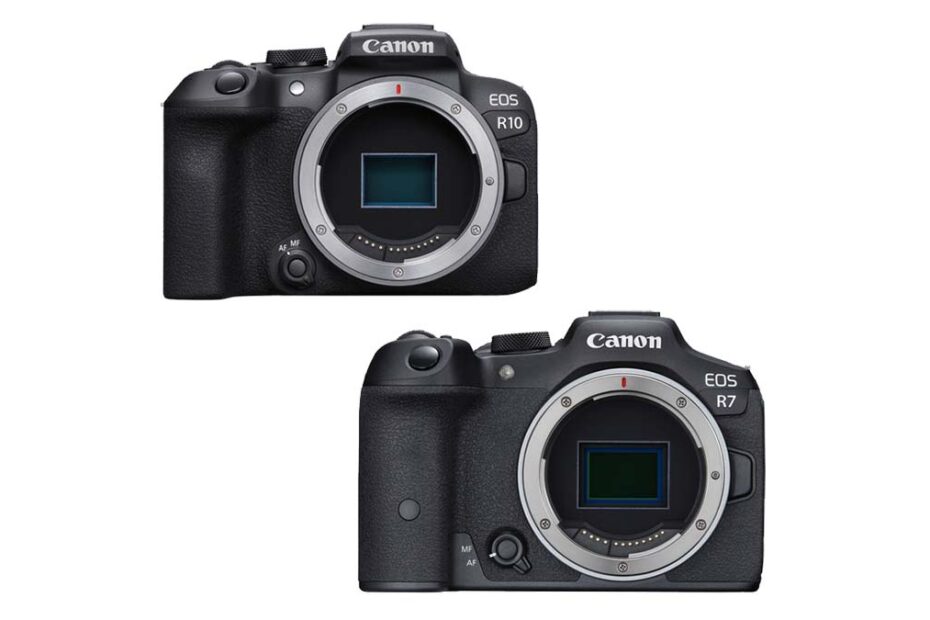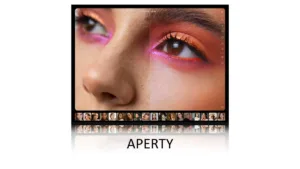In this post, we compare the Canon R10 vs R7 to find out which of the two might be best for you. Broadly speaking, the Canon R10 appears to be a mirrorless alternative to Canon’s entry-level Rebel Digital SLRs. Whilst the Canon R7 appears to rival Canon’s 90D and the EOS M6m11.
But whichever camera you chose, both the R10 and R7 will grant you access to Canon’s full-frame RF lenses – plus its EF and EF-M DSLR lenses via an adapter. Therefore, the Canon R10 and R7 present a more affordable opportunity for Canon owners to transition from their Canon’s DSLR to mirrorless. Jump to Conclusion
Table of contents
What’s the difference between the Canon R10 and R7
The Canon R10 and R7 are 2 very different cameras aimed to meet different needs. Broadly speaking, the Canon R10 is well set to meet the needs of photographers with the Canon R7 being a more capable video camera.

Image Quality
The Canon R7 features a 32.5 megapixel front-side illuminated APS-C sensor. Whereas the R10’s sensor makes do with 24.2 megapixels.

Canon’s decision to use front-side illuminated sensors is a little out-of-step with the rest of the industry since most manufacturers have shifted towards a more efficient Back Side Illuminated (BSI) design. Typically, BSI sensors produce less noise and more dynamic range at high ISOs. Therefore, it will be interesting to see how these Canon sensors compare with those from Nikon, Sony, and Fujifilm.
Image Stabilization
The Canon R10 lacks in-built image stabilization (IBIS). In contrast, Canon claims the R7’s in-body stabilization is effective up to 7 Stops.

Whether or not the inclusion of IBIS matters to you depends on your favorite type of photography and your choice of lens. If you tend to shoot at faster shutter speeds, from a tripod, or with optically stabilized lenses, you’ll be fine.
However, IBIS offers the best stabilization for hand-held videography and, of course, works with any lens. For me, the absence of IBIS on the Canon R10 is disappointing – especially as it’s available on the similarly priced Fujfilm X-S10.
Video
Both the Canon R7 and R10 can capture 10-Bit 4K60p. Yet, several discrete but important differences make the R7 the superior video camera.

First of all, the Canon R7’s inbuilt image stabilization means your hand-held video will be much smoother. And whilst the Canon R10 can capture detailed 6K super-sampled 4K up to 30 frames per second, 4K60p is less detailed and cropped.
However, the Canon R7’s 4K footage is super-sampled from 7K and it works up to 4K60p without any cropping. Furthermore, only the R7 can record in Canon Log.
And finally, both cameras feature a 3.5mm jack for your external microphone. But only the R7 has a headphone jack.
Price
The US$979 Canon R10 costs much less than the $1499 Canon R7.
Body
The Canon R7 is a little larger and appreciably heavier than the featherweight Canon R10. However, the extra bulk does come with some advantages.

First of all, the Canon R7 offers 2 card slots whilst the Canon R10 makes do with one. And whilst the Canon R10’s viewfinder offers a generous .95x magnification, the Canon R7 delivers 1.15x. It’s much the same story with the rear LCD panel with the Canon R10’s 1.04 million dot pixel display up against the 1.62 million dot display on the Canon R7.
As for ergonomics, both cameras feature custom settings, a dedicated AF-On button, and an AF joystick. But like the Rebel DSLRs it replaces, the R10 offers just one dial for adjusting your exposure settings. If that’s not enough for you, the R7 has three.
Canon R10 vs R7 Specs Comparison
| Canon R10 | Canon R7 | |
|---|---|---|
| Release Date | 25 May 22 | 25 May 22 |
| Price | US$979 | US$1499 |
| Sensor | ||
| Format | APS-C | APS-C |
| Resolution | 24.2 Megapixels | 32.5 Megapixels |
| Stabilization | No | Yes: up to 7 Stops |
| Native ISO Range | 100-3200 | 100-3200 |
| Autofocus | ||
| AF Type | Contrast/Phase Detect | Contrast/Phase Detect |
| AF Focus Points | 651 | 651 |
| AF Sensitivity (Max) | EV-4 to 20 | EV -5 to 20 |
| AF Point Coverage | 100% Approx | 100% Approx |
| Physical Shutter | ||
| Max Shutter Speed | 30 – 1/4000 | 30-1/4000 |
| Max FPS (Max Res AF + AE) | 15 | 15 |
| E-Shutter | ||
| Max Shutter Speed | 30 – 1/16000 | 30- 1/16000 |
| Max FPS (Max Res AF + AE) | 21 | 30 |
| Video | ||
| 8K | No | No |
| 4K | 24,25,30,50p,(60p Cropped) | 24,25,30,50p,60p |
| 1080p HD | 24,25,30,50,60,100,120p | 24,25,30,50,60,100,120p |
| Format | MP4 | MP4 |
| Storage | ||
| Card Slot One | SD, SDHC, SDXC | SD, SDHC, SDXC |
| Card Slot Two | None | SD, SDHC, SDXC |
| Viewfinder | ||
| Type | 0.39 inch OLED | 0.39 inch OLED |
| Resolution | 2.36m | 2.36m |
| Refresh Rate | 59/119 fps | 59/119 fps |
| Magnification | 0.95x | 1.15x |
| Display | ||
| Size | 3-inch | 3-inch |
| Resolution | 1.04m | 1.62m |
| Touch Sensitive | Yes | Yes |
| Mobility | Fully Articulating | Fully Articulating |
| Connectivity | ||
| Video-Out | HDMI Micro D | HDMI Micro D |
| Audio-in (Mic) | 3.5mm | 3.5mm |
| Audio-out (Headphones) | No | 3.5mm |
| Data | USB-C 2 | USB-C 3.2 |
| Power | AC Power | AC Power |
| Bluetooth | Yes | Yes |
| WiFi | Yes | Yes |
| Ethernet | No | No |
| Internal GPS | No | No |
| Power | ||
| Battery | LP-E17 | LP-E6NH/LP-EP6 |
| Battery Life | 660 | 500 |
| Video Record Time | ||
| USB Charging | ||
| Body | ||
| Length | 122.5mm | 132mm |
| Height | 87.8mm | 90.4mm |
| Depth | 83.4mm | 91.7mm |
| Weight | 426 grams | 612 grams |
| Get Full Specifications | R10 Specs | R7 Specs |
Get Discounts
If you would like to be notified of deals and discounts on camera gear and photography software – sign up for my weekly email. You’ll receive no more than one email a week and you can unsubscribe anytime. Subscribe
Canon R10 vs R7 – Which should you buy
Modern-day Rebel
In making the R10, Canon has effectively created a mirrorless version of its best-selling Rebel DSLR. In other words, the Canon R10 is an affordable route toward pro-grade image quality and photography. And because this is 2022, the R10 enjoys modern-day perks such as subject-recognition autofocus, fast continuous shooting, and 10-bit super-sampled 4K video.

However, the lack of in-built image stabilization on the Canon R10 is a shame as its absence undermines the effectiveness of some of the features you’re paying for. So, if you want to shoot at slow shutter speeds or capture smooth hand-held video footage – you’ll need to look elsewhere.
Elsewhere
Elsewhere, of course, is the Canon R7. Not only does the Canon R7 feature 7-stops worth of image stabilization but it has more megapixels, superior 4K, and a more versatile body. It’s almost like Canon made the Canon R7 address the R10’s shortcomings for only 50% more money. Weird.
Alternatives
But for the same money as a Canon R10, you can buy a Fujifilm X-S10. Unlike the Canon R10, the Fuji X-S10 does feature image stabilization and as a result, might be a superior option for video despite its 8-bit 4K. Photography-wise, the Fuji has a few more megapixels, a much wider offering of lenses, and some nice film simulations.
Overall
The Canon R10 and R7 deserve your attention – particularly if you’re currently shooting one of Canon’s APS-C DSLRs. Not only will you be able to bring your lenses over, but you’ll be able to enjoy mirrorless perks such as frame-wide subject recognition and eye detect autofocus, fast continuous shooting, and high-quality video.
If you’re on a budget, the Canon R10 combines great value, a feather-weight body, decent video, and very fast continuous shooting. However, the absence of IBIS is an inconvenience to photography and undermines the R10’s otherwise excellent video quality. But for quite a bit more money, the R7 gives you IBIS, more resolution, better video, and dual card slots. Whilst I’d like to make it easy for you, which is best depends on you. Back to Intro
Recent Posts
- Aperty – Dedicated AI-Powered Portrait Enhancement
- ON1 Photo Raw 2024.5 Review – A little Unfriendly, Very Rewarding
- Topaz Photo AI Review – Excellence in Slow Motion
- Gigapixel Review – Is it Fixed?
- ON1 NoNoise AI 2024 Review – Outstanding and Affordable
- DxO PureRAW 4 Review – Not for Everyone. Perfect for Some





